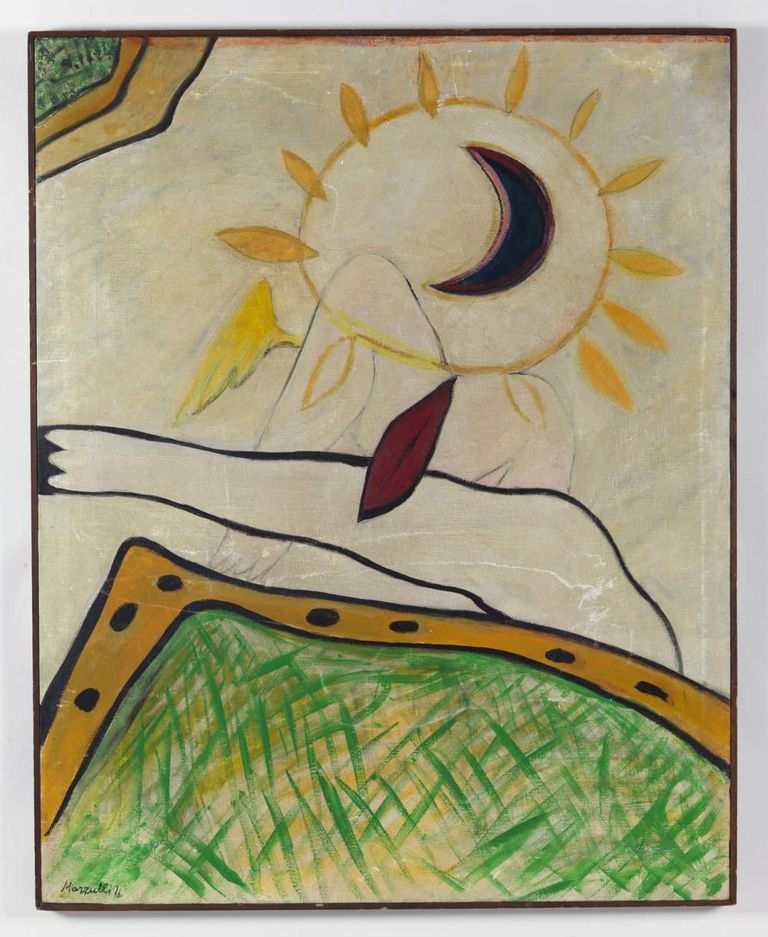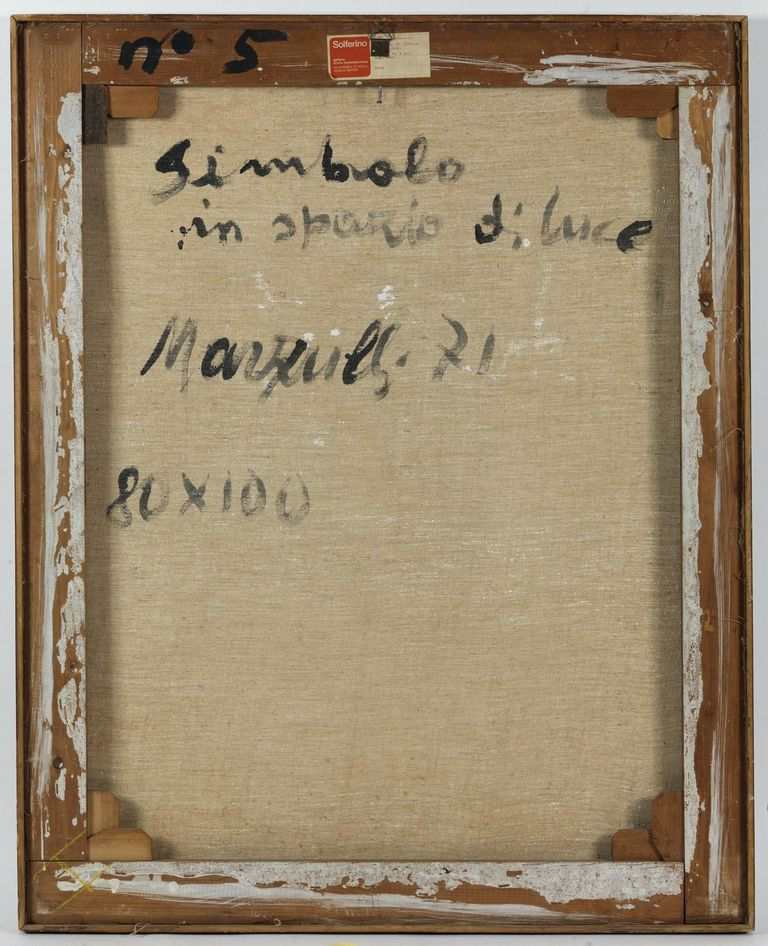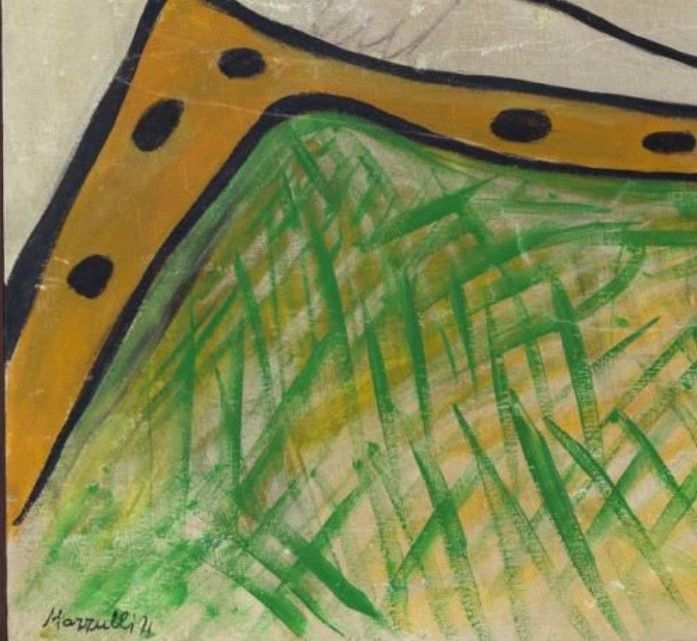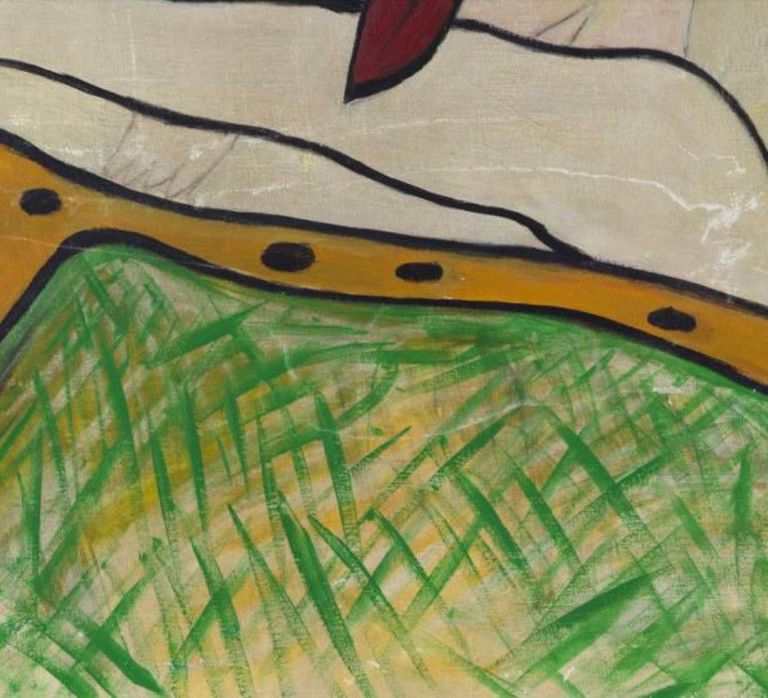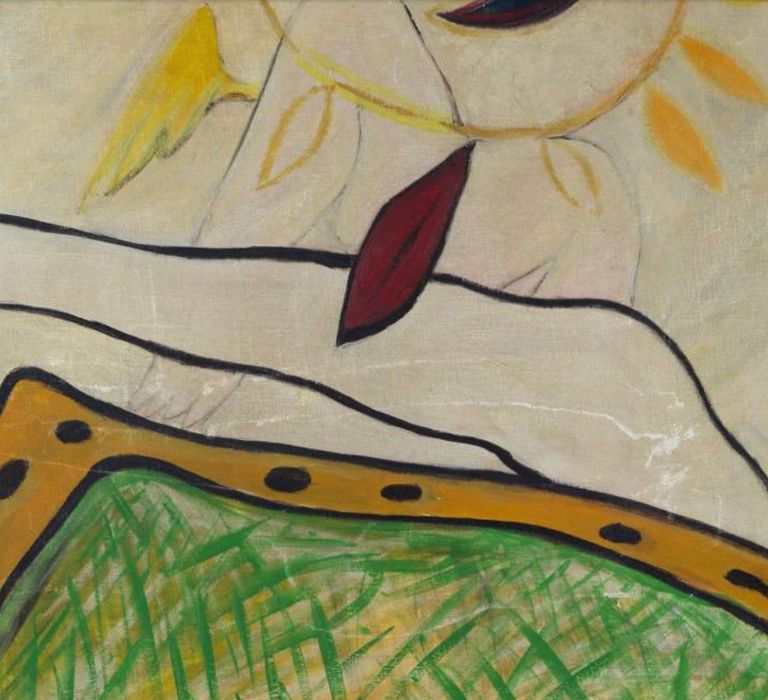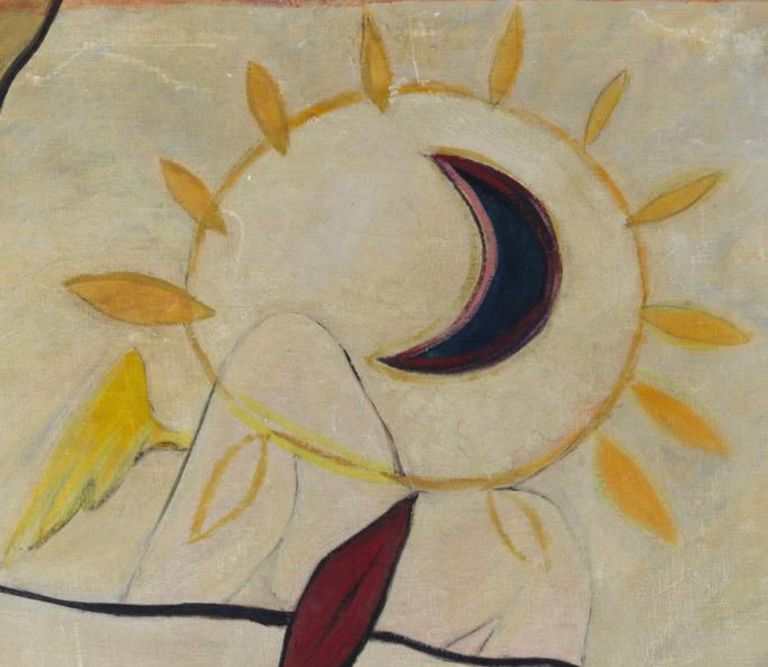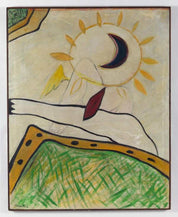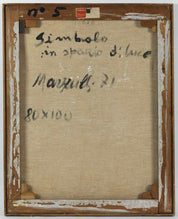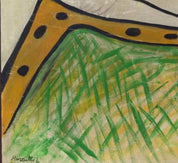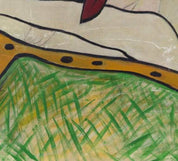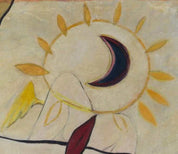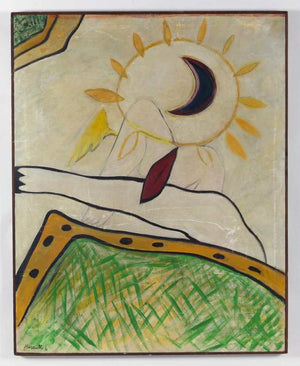Similar Items
Lino Marzulli ;Simbolo in spazio di luce'.
$700.00 USD
Artist: Lino Marzulli
Title: Simbolo in Spazio di Luce
Date: 1971
Medium: Oil on Canvas
Dimensions: 80 x 100 cm
Description: Immerse yourself in the captivating world of "Simbolo in Spazio di Luce," a masterpiece by the esteemed artist Lino Marzulli. This 1971 oil painting on canvas offers a mesmerizing journey through light, symbolism, and artistic expression.
Measuring 80 x 100 cm, Marzulli's artwork commands attention with its striking presence. The interplay of light and shadow, combined with the artist's masterful brushwork, creates a harmonious composition that draws you in.
Marzulli's ability to convey depth and emotion through his chosen medium is evident in every stroke. The title, "Simbolo in Spazio di Luce," invites you to explore the layers of meaning that this artwork encapsulates. A signature and date grace the lower left corner, a testament to the artist's commitment to his creation.
Turn the artwork around, and you'll discover a treasure trove of information on the back. The title, signature, year, and a label from the prestigious Solferino Gallery in Milan adorn the reverse. Despite some defects, this painting continues to carry its unique charm and narrative.
"Simbolo in Spazio di Luce" transports you to a realm where visual art transcends the canvas. Marzulli's work is a testament to his ability to capture both the tangible and the intangible, inviting you to embark on a contemplative journey that resonates with the soul.
ino Marzulli was born in Sesto San Giovanni on 16 December 1929.
His time was marked by the howl of the sirens of the big industries. Since he was a boy, he has been drawing and getting to know the great artists within the limits that a modest family allowed him. The difficult post-war situation did not allow him to undertake artistic studies towards which he felt a strong attraction. He then attended an industrial technical school which allowed him to work as a draftsman. In 1955 he enrolled in the Faruffini School of Art directed by Giovanni Fumagalli in which, over the course of five years, he learned the profession of painter. These were years of intense visits between young Milanese artists, galleries, museums and theoretical art courses.
In the early 1960s things happen that will change his life. He teaches color techniques at the Rizzoli Institute in Milan and, with a first group of artists, begins to live in the "Quartiere delle Botteghe" in Sesto San Giovanni. During this stay he has the opportunity to get to know the critical and artistic militancy and the young Italian and foreign avant-gardes. He experiments with new materials and techniques while always pursuing the discourse of painted painting. During these years he made frequent trips to Italy and abroad with a long stay in Venice where he began his exhibition activity. He knows and hangs out with artists and personalities linked to the art world.
In 1966 he moved his studio to Milan first in Via Pontida, where he remained until 1968, the year in which, together with other artists, he entered the heart of the protest by occupying the Milan Triennale, and then in Via Fiori Chiari where he remained for almost twenty 'years. He carries on his work coherently, despite the trend of the artists in those years towards the "rejection of bourgeois art". For Marzulli, a man of the left, making art is not a socio-political choice: proof of this is his remarkable production in that period detached from formulas, but always within cultural battles. Since 1973, and for over thirty years, he assiduously frequents the Cinque Terre, while maintaining Milan as his habitual residence. In Riomaggiore he begins to paint the rugged hills and the stormy sea that were already by Telemaco Signorini.
His activity expands and there are countless group and personal exhibitions. He uses materials like wood, plaster, etc. for painted objects, he makes large canvases and there are numerous mosaics, glass, frescoes and ceramics. Finally, the Marzulli of his last period was discovered in 1987 when he opened his new studio in via Maroncelli, also in Milan. The workshop becomes a point of reference for young artists, fills the void left by the short-sightedness of our institutions and becomes a breeding ground for painters in search of experience and visibility. Marzulli's studio hosts about twenty exhibitions of semi-unknown artists and gives life to debates, meetings, seminars on the theme of art.
At the same time, the "master" continued his artistic research: the series of zodiac signs, paintings cut into small fragments, and the astonishing luminous glass windows that Marzulli created in the Brescia glassworks date back to this period. Finally, the transfer to the large studio in Via Calabiana, also in Milan. Here Marzulli travels through the last period of his work, one of the most fervent of his adventure as an artist. The considerable size of the studio allows him, more easily than in the past, to devote himself to large-scale works for both public and private clients. The new premises, as before, are an opportunity to host temporary exhibitions of artist friends as well as meetings and debates, continuing to conceive the workplace also as a moment of aggregation, exchange of ideas and friendship.
He throws himself into his work with enthusiasm, cut short by his death in November 2007.
Title: Simbolo in Spazio di Luce
Date: 1971
Medium: Oil on Canvas
Dimensions: 80 x 100 cm
Description: Immerse yourself in the captivating world of "Simbolo in Spazio di Luce," a masterpiece by the esteemed artist Lino Marzulli. This 1971 oil painting on canvas offers a mesmerizing journey through light, symbolism, and artistic expression.
Measuring 80 x 100 cm, Marzulli's artwork commands attention with its striking presence. The interplay of light and shadow, combined with the artist's masterful brushwork, creates a harmonious composition that draws you in.
Marzulli's ability to convey depth and emotion through his chosen medium is evident in every stroke. The title, "Simbolo in Spazio di Luce," invites you to explore the layers of meaning that this artwork encapsulates. A signature and date grace the lower left corner, a testament to the artist's commitment to his creation.
Turn the artwork around, and you'll discover a treasure trove of information on the back. The title, signature, year, and a label from the prestigious Solferino Gallery in Milan adorn the reverse. Despite some defects, this painting continues to carry its unique charm and narrative.
"Simbolo in Spazio di Luce" transports you to a realm where visual art transcends the canvas. Marzulli's work is a testament to his ability to capture both the tangible and the intangible, inviting you to embark on a contemplative journey that resonates with the soul.
ino Marzulli was born in Sesto San Giovanni on 16 December 1929.
His time was marked by the howl of the sirens of the big industries. Since he was a boy, he has been drawing and getting to know the great artists within the limits that a modest family allowed him. The difficult post-war situation did not allow him to undertake artistic studies towards which he felt a strong attraction. He then attended an industrial technical school which allowed him to work as a draftsman. In 1955 he enrolled in the Faruffini School of Art directed by Giovanni Fumagalli in which, over the course of five years, he learned the profession of painter. These were years of intense visits between young Milanese artists, galleries, museums and theoretical art courses.
In the early 1960s things happen that will change his life. He teaches color techniques at the Rizzoli Institute in Milan and, with a first group of artists, begins to live in the "Quartiere delle Botteghe" in Sesto San Giovanni. During this stay he has the opportunity to get to know the critical and artistic militancy and the young Italian and foreign avant-gardes. He experiments with new materials and techniques while always pursuing the discourse of painted painting. During these years he made frequent trips to Italy and abroad with a long stay in Venice where he began his exhibition activity. He knows and hangs out with artists and personalities linked to the art world.
In 1966 he moved his studio to Milan first in Via Pontida, where he remained until 1968, the year in which, together with other artists, he entered the heart of the protest by occupying the Milan Triennale, and then in Via Fiori Chiari where he remained for almost twenty 'years. He carries on his work coherently, despite the trend of the artists in those years towards the "rejection of bourgeois art". For Marzulli, a man of the left, making art is not a socio-political choice: proof of this is his remarkable production in that period detached from formulas, but always within cultural battles. Since 1973, and for over thirty years, he assiduously frequents the Cinque Terre, while maintaining Milan as his habitual residence. In Riomaggiore he begins to paint the rugged hills and the stormy sea that were already by Telemaco Signorini.
His activity expands and there are countless group and personal exhibitions. He uses materials like wood, plaster, etc. for painted objects, he makes large canvases and there are numerous mosaics, glass, frescoes and ceramics. Finally, the Marzulli of his last period was discovered in 1987 when he opened his new studio in via Maroncelli, also in Milan. The workshop becomes a point of reference for young artists, fills the void left by the short-sightedness of our institutions and becomes a breeding ground for painters in search of experience and visibility. Marzulli's studio hosts about twenty exhibitions of semi-unknown artists and gives life to debates, meetings, seminars on the theme of art.
At the same time, the "master" continued his artistic research: the series of zodiac signs, paintings cut into small fragments, and the astonishing luminous glass windows that Marzulli created in the Brescia glassworks date back to this period. Finally, the transfer to the large studio in Via Calabiana, also in Milan. Here Marzulli travels through the last period of his work, one of the most fervent of his adventure as an artist. The considerable size of the studio allows him, more easily than in the past, to devote himself to large-scale works for both public and private clients. The new premises, as before, are an opportunity to host temporary exhibitions of artist friends as well as meetings and debates, continuing to conceive the workplace also as a moment of aggregation, exchange of ideas and friendship.
He throws himself into his work with enthusiasm, cut short by his death in November 2007.
Popular Items
































